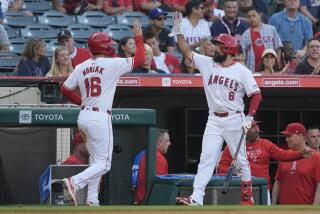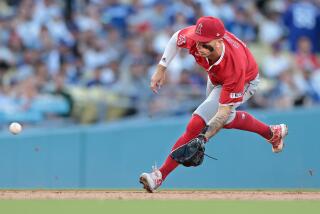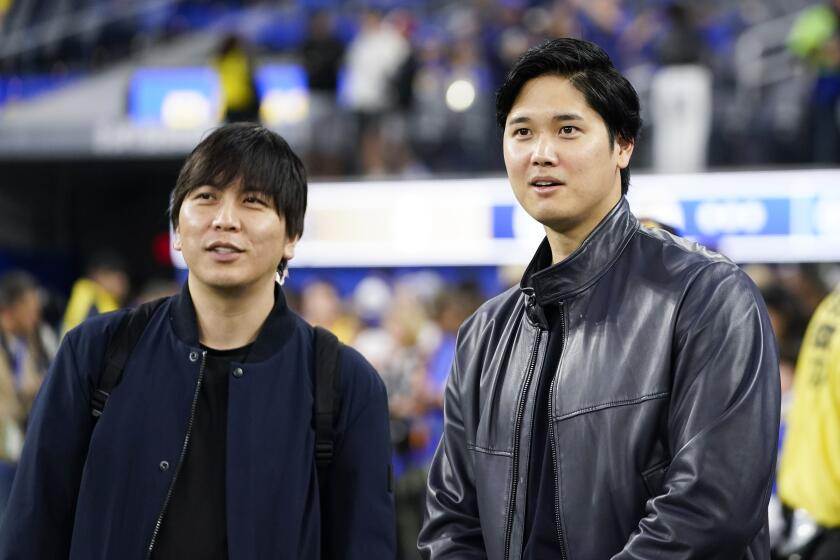Angels have a rare opportunity in draft
You don’t have to explain to Eddie Bane what a crapshoot baseball’s amateur draft can be.
He can tell you firsthand about the time the Minnesota Twins spent their first-round pick on a surefire left-hander who went 40-4 with a 1.64 earned-run average, a school-record 505 strikeouts and a perfect game at Arizona State. Kid was so good, his first start after college came before 45,000 at the Metrodome, where he held the Kansas City Royals to a run and three hits in seven innings.
Pretty good pick, huh?
Well, not really, because Eddie Bane would make only 24 more starts in the major leagues before washing out at age 24 with a 7-13 career record.
“You’re going to miss,” says Bane -- yes, that Bane -- who is now in his sixth season as director of scouting for the Angels. “You’ve got to take those kinds of chances.”
Especially this year. Bane and the Angels, who have had only one first-round pick in the last four drafts, will make five selections before the second round this time around, giving them a much-needed chance to strengthen a thinning farm system. The Dodgers, conversely, will have only one pick (at No. 36) in the first 55 selections of the three-day, 50-round draft, which begins June 9.
Although the Angels have gone for pitching in the last five drafts, the team is looking for power this year, making 17-year-old outfielder Mike Trout of New Jersey a possible first-round pick. Trout batted .521 with 15 homers in 71 at-bats as a senior.
The Angels are also believed to be interested in Texas prep Everett Williams, La Verne Bonita High shortstop Jiovanni Mier and Santa Monica High left-hander Tyler Skaggs.
“It’s a great opportunity,” Bane says of the Angels’ picks. “We’re never going to pick in the top 10 that I can foresee because we’re so good at the big league level. So this is a unique deal. We’re looking forward to it.”
The draft order is determined by a team’s performance the previous season with teams picking in reverse order of their finish. So the Washington Nationals, the worst team in baseball last season, will have the first choice. That also explains why the Angels, with one losing season in Mike Scioscia’s nine seasons as manager, have made only one pick in the top half of the draft since 2002.
This year, however, the Angels received the New York Mets’ and Yankees’ first-round picks (No. 25 and No. 26, respectively) as well as supplemental first-round picks as compensation for those teams’ signings of free agents Francisco Rodriguez (Mets) and Mark Teixeira (Yankees). Arizona’s signing of another former Angel, free-agent pitcher Jon Garland, netted the Angels an additional supplemental pick, giving them five of the draft’s first 48 picks.
Only the Diamondbacks, with five of the first 45 selections, will do better.
“It’s important. But every draft is important,” says General Manager Tony Reagins, who ran the Angels’ player development department for six years before being promoted before last season. “This one happens to be more significant because of the selections that we have so early in the draft. So you want to be able to get good quality players with those selections.”
In recent years the Angels have built a reputation for using their early picks on high school players, spending more than half of their first 10 picks -- and all of their top picks -- that way in the last four drafts. It’s a risky strategy because teenagers are more difficult to project than college players. But it also brings with it the possibility of greater reward if those projections prove correct.
“When the opportunity comes to have to replace Garret Anderson -- or to replace any of our guys -- you’re not going to replace them with some huge college guy that hits .260 or something in the big leagues,” Bane says. “You’ve got to replace them with guys that will hit for similar abilities. The only way to get those guys is to take a shot at some high school guy.”
And the Angels’ success rate has been pretty good. Of the last four high school players the Angels selected with their first pick, pitchers Tyler Chatwood and Trevor Bell and catcher Hank Conger are playing well, though none have progressed past double A. But the fourth, pitcher Jonathan Bachanov, drafted in 2007, has had arm and elbow problems and has yet to make his professional debut.
“Just as a philosophy, we’ve never really played it safe,” Reagins says. “We’ve always been aggressive in the draft. And we’ll do that again.”
--
--
BEGIN TEXT OF INFOBOX
Angels hits and misses
Unlike with the NFL and NBA drafts, it can take years to fully evaluate how successful a baseball team has been in its draft. In Eddie Bane’s five seasons as director of scouting, the Angels have had some clear hits -- and misses.
HITS
(Player, draft year, performance)
Jered Weaver, RHP, 2004 1st round, 39-21, 3.54 ERA.
Freddy Sandoval, INF, 2004 8th round, .298 BA in five minor league seasons.
Hank Conger, C, 2005 1st round, .296 BA in four minor league seasons.
Sean O’Sullivan, RHP, 2005 3rd round, 35-19 with a 3.66 ERA in four minor league seasons.
Nick Adenhart, RHP, 2004 14th round, 37-28, 3.87 ERA in four minor league seasons; died in car crash in April.
MISSES
Jonathan Bachanov, RHP, 2007 1st round supplemental, had reconstructive elbow surgery shortly after signing in 2007 and has yet to throw an inning in pro ball.
Patrick White, OF, 2004 4th round; 2007 24th round, drafted twice despite the fact he seemed certain to play football.
Matt Harvey, RHP, 3rd round 2007. The top prep pitcher in the country as a senior, Harvey turned down a reported $1 million to play college baseball at North Carolina.
Trevor Pippin, OF, 4th round 2007. Highly touted out of junior college, batted .183 in two seasons in rookie ball.
P.J. Phillips, SS, 2nd round 2005. Hasn’t advanced beyond Class A. Batting .203 through 41 games at Rancho Cucamonga.
-- Kevin Baxter
More to Read
Go beyond the scoreboard
Get the latest on L.A.'s teams in the daily Sports Report newsletter.
You may occasionally receive promotional content from the Los Angeles Times.







